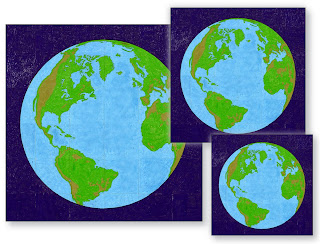 My young journal students seem to work best with multi-step projects, so this stamp, trace, write and color page kept them busy for most of our 60-minute class. Plus, I love the irregular pattern that the watercolor makes.
My young journal students seem to work best with multi-step projects, so this stamp, trace, write and color page kept them busy for most of our 60-minute class. Plus, I love the irregular pattern that the watercolor makes.1. Save your paper towel and toilet paper rolls, because they make great disposable stampers, using watercolor paint. I had a theme of "blue" going for the day, so I filled small bowls with a little watery paint for students to stamp circles on their journal pages. A paper towel dabbing then dried the pages pretty quickly.
2. Using a gel pen, the students were asked to trace around both sides of the circles they made, taking care to follow all the wiggly edges.
3. Using the gel pens again, I had the students brainstorm on all the different colors of blue they could think of. Newly made up words were encouraged.
4. The students used a colored pencil to fill in the area around the circles. Dark coloring was encouraged to create a lot of contrast. Lots of variations of this process are possible.


 9:07 PM
9:07 PM
 keprok
keprok





























